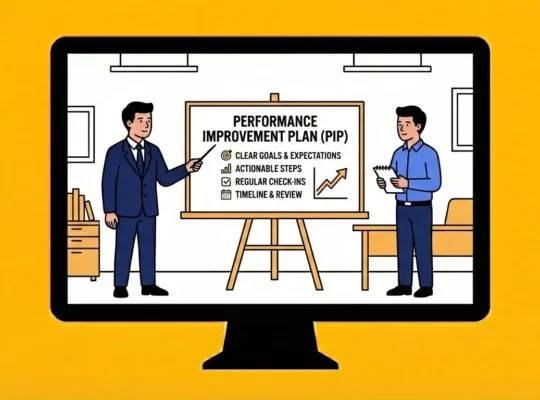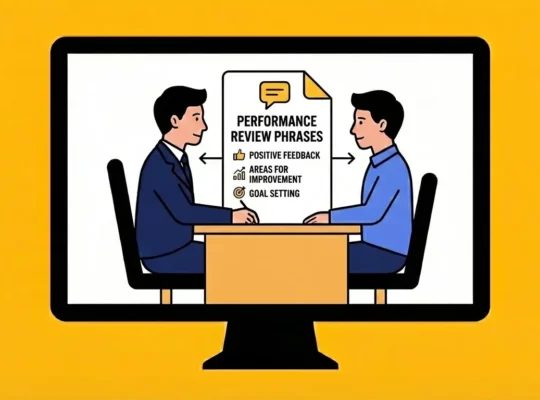Fostering a culture of open communication and strong relationships between employees and managers is paramount to success. Regular check-ins, structured meetings designed for open dialogue and feedback exchange, are a powerful tool for achieving these goals. Here at Review.jobs, we understand the transformative power of communication in building stronger teams and driving performance. This article delves into check-ins, exploring their purpose, benefits, and best practices for implementation. By strategically incorporating regular check-ins into your performance management strategy, you can cultivate a thriving work environment where employees feel valued, supported, and empowered to reach their full potential.
- What Are Check-ins?|
- Goals of Conducting Check-ins
- Benefits of Regular Check-ins
- Implementing Effective Check-Ins
- Beyond Check-ins: Uncovering Deeper Employee Sentiment with Review.jobs
I. What Are Check-ins?
At their core, check-ins are dedicated time slots for managers and employees to connect regularly. These meetings serve a specific purpose – to build strong working relationships, ensure alignment on priorities, provide and receive feedback, and address any challenges that might hinder progress. The primary goal of check-ins is to guarantee everyone is on the same page, working towards shared objectives with clarity and focus.
II. Goals of Conducting Check-ins
Check-ins are designed to serve as a cornerstone of effective employee management, fostering open communication, alignment, and growth. By focusing on the following key areas, check-ins can significantly enhance employee engagement and overall organizational performance:
Building Relationships
By regularly interacting face-to-face (or virtually), managers and employees can establish a strong foundation of trust and understanding. Check-ins provide an opportunity to learn about each other’s work styles, goals, and aspirations, fostering a more collaborative and supportive work environment.
Balancing Priorities
Work demands can shift rapidly, and priorities can become unclear. Check-ins offer a dedicated time for both parties to discuss workload, identify potential conflicts, and ensure individual tasks seamlessly align with broader team objectives. By adjusting priorities proactively, teams can stay focused on delivering high-quality work.
Sharing Feedback
Check-ins create a safe space for open and honest feedback exchange. Managers can provide constructive feedback to help employees develop their skill sets and improve their performance. Managers can also ask insightful performance review questions for optimal performance improvement.
Additionally, employees can share their feedback on projects, processes, or even workplace dynamics, allowing managers to identify areas for improvement and make necessary adjustments.
Problem-Solving
Challenges and roadblocks are inevitable in any project. Check-ins provide a platform for identifying issues early on and brainstorming solutions collaboratively. By fostering open communication and encouraging early problem identification, teams can resolve challenges efficiently and minimize disruptions to workflow.
III. Benefits of Regular Check-ins
Increased Productivity
Regular check-ins serve as a proactive approach to identifying and addressing potential roadblocks. By fostering open communication and aligning individual goals with team objectives, check-ins minimize the risk of miscommunication and ensure everyone is working towards the same targets. This streamlined workflow leads to increased productivity and overall efficiency.
Improved Employee Engagement
When employees feel heard, valued, and supported, their engagement levels soar. Check-ins provide a platform for employees to share their ideas, concerns, and accomplishments. This sense of involvement and recognition boosts morale and creates a positive work environment.
Enhanced Problem-Solving and Decision Making
Regular check-ins encourage a culture of problem-solving and collaboration. By discussing challenges openly and brainstorming solutions together, teams can develop innovative approaches and overcome obstacles more effectively. This collaborative approach strengthens team dynamics and leads to better decision-making.
Stronger Relationships and Teamwork
Check-ins are not just about work; they are also about building relationships. Regular one-on-one conversations foster a sense of trust, empathy, and camaraderie among team members. This strengthens employee connections and creates a more supportive work environment.
Early Identification of Issues
Check-ins provide an early warning system for potential problems. By addressing issues proactively, organizations can prevent them from escalating into larger problems. This helps to maintain a positive work environment and avoid costly disruptions.
IV. 4 Steps Guide for Effective Check-Ins
1. Establishing a Check-In Cadence
Determining the optimal frequency for check-ins is crucial for their success. Several factors influence this decision, including company size, industry, team structure, and employee preferences. While there’s no one-size-fits-all approach, consider these guidelines:
- Start with a Bi-Weekly Cadence: For most teams, starting with bi-weekly check-ins provides a good balance between regularity and depth.
- Flexibility is Key: Be prepared to adjust the frequency based on team feedback and evolving needs. Some teams may benefit from weekly check-ins, while others may prefer monthly meetings.
- Consider Role-Based Variations: Different organizational roles may require varying check-in frequencies. For example, high-performing or newly hired employees might benefit from more frequent check-ins.
2. Preparing for Productive Check-Ins
Effective check-ins require preparation from both managers and employees. Here are some key steps to ensure productive meetings:
- Develop a Clear Agenda: Outline the key topics to be discussed during the check-in, such as goals, progress, challenges, and feedback.
- Allocate Sufficient Time: Ensure that check-ins are scheduled for a dedicated time slot, free from interruptions.
- Create a Comfortable Atmosphere: Foster a relaxed and open environment where employees feel comfortable sharing their thoughts and concerns.
- Leverage Technology: Utilize tools like video conferencing and screen sharing to enhance remote check-ins.
3. Conducting Meaningful Check-Ins
The success of a check-in lies in its ability to foster open dialogue and build trust. Here are some tips for conducting meaningful check-ins:
- Active Listening: Give employees your undivided attention and demonstrate empathy through active listening.
- Two-Way Communication: Encourage open and honest feedback from both the manager and the employee.
- Focus on Solutions: Use check-ins to identify problems and brainstorm solutions together.
- Set Clear Expectations: Outline the next steps and action items at the end of each check-in.
- Follow-up: Ensure that commitments made during the check-in are followed through.
4. Following Up After Check-Ins
To maximize the impact of check-ins, it’s essential to follow up on action items and track progress.
- Document Key Points: Summarize the main points discussed during the check-in and share them with both parties.
- Set Clear Deadlines: Establish clear timelines for completing action items and follow up to ensure progress.
- Measure Impact: Track the outcomes of check-ins to assess their effectiveness and make necessary adjustments.
- Continuous Improvement: Regularly review the check-in process to identify areas for improvement and make necessary adjustments.
V. Beyond Check-ins: Uncovering Deeper Employee Sentiment with Review.jobs
While regular check-ins are a powerful tool for fostering communication and addressing immediate concerns, they may not always capture the full spectrum of employee experience. There might be underlying issues or sentiments that employees hesitate to bring up in a face-to-face setting. Review.jobs empowers organizations to go beyond scheduled conversations and cultivate a culture of continuous feedback through the following features:
Anonymous Employee Reviews
Providing a platform for anonymous employee reviews allows employees to share honest and unfiltered feedback without fear of repercussions. By offering anonymity, Review.jobs empowers employees to participate in open and honest communication, ultimately leading to a more positive and productive work environment.
This is particularly valuable for uncovering:
- Unvoiced Concerns: Employees may have anxieties or worries they wouldn’t feel comfortable raising directly with their manager. Anonymous reviews provide a safe space to voice these concerns, allowing management to address them proactively.
- Constructive Criticism: Sometimes, employees may feel hesitant to offer constructive criticism directly to their manager. Anonymous reviews provide a neutral platform for such feedback, enabling managers to identify areas for improvement without creating tension.
- Hidden Issues: Issues like company culture, leadership styles, or team dynamics can be difficult to assess through traditional methods. Anonymous reviews offer valuable insights into these often-overlooked areas.
Smart Feedback Management
Managing a constant stream of employee reviews can be overwhelming. Review.jobs offers a user-friendly platform with an intuitive dashboard that streamlines the process. This comprehensive suite of features empowers organizations to effectively manage employee feedback, gain valuable insights, and implement data-driven improvements.
Key features include:
- Review Moderation: Tools to moderate reviews, ensuring they are respectful and constructive.
- Reporting and Labeling: Generate reports and categorize reviews based on themes or departments, allowing for targeted analysis.
- Employee Satisfaction Metrics: Track key employee satisfaction metrics over time to measure the impact of feedback initiatives.
Sentiment Analysis
Going beyond the text itself, Review.jobs utilizes sentiment analysis tools to gauge the overall emotional tone of employee feedback. It provides a deeper understanding of employee sentiment, enabling organizations to cultivate a more positive and supportive work environment.
This allows companies to:
- Uncover Underlying Emotions: Text analysis can reveal hidden emotions like frustration, discouragement, or low morale that may not be explicitly expressed.
- Identify Trends: Track sentiment trends over time to understand how employee morale is evolving.
- Prioritize Concerns: By identifying areas with negative sentiment, organizations can prioritize the issues that require immediate attention.
Regular check-ins are a cornerstone of effective employee performance management. They foster open communication, create a sense of trust and support, and ensure everyone is aligned toward common goals. By prioritizing these conversations, organizations can drive productivity, enhance employee engagement, and foster a thriving work environment. However, check-ins alone may not paint the whole picture. Review.jobs recognizes the limitations of solely relying on scheduled conversations. Our platform empowers organizations to go beyond check-ins by providing a multifaceted approach to continuous feedback





